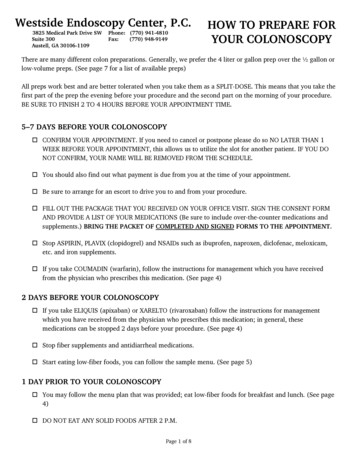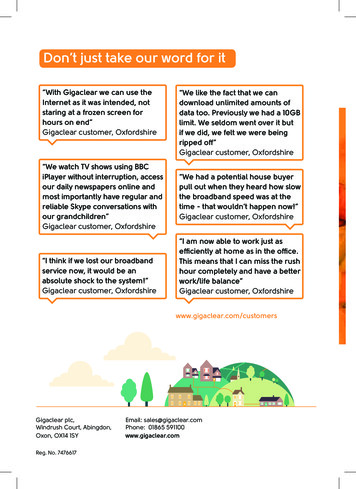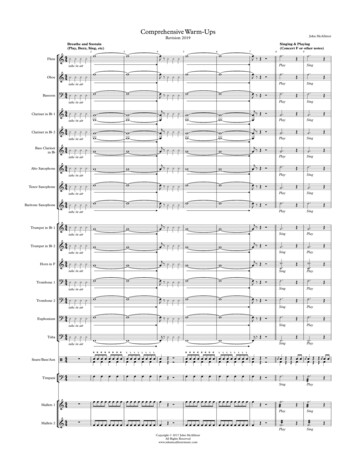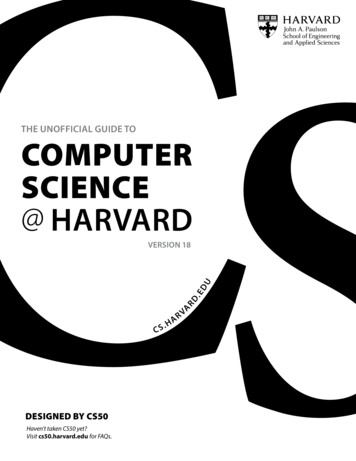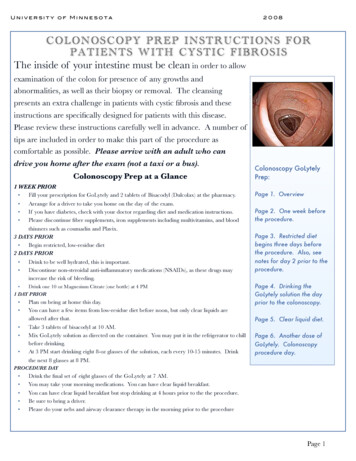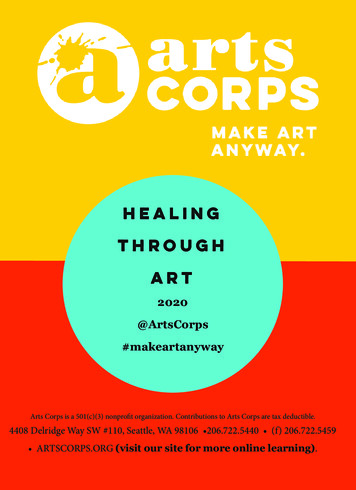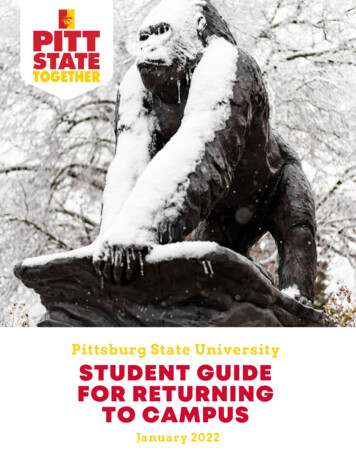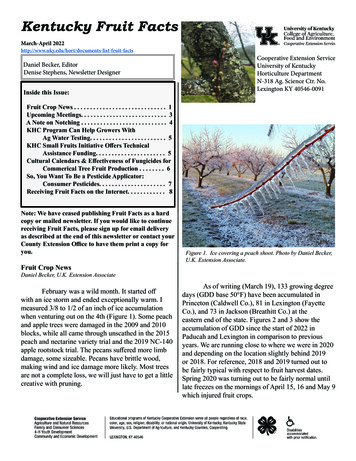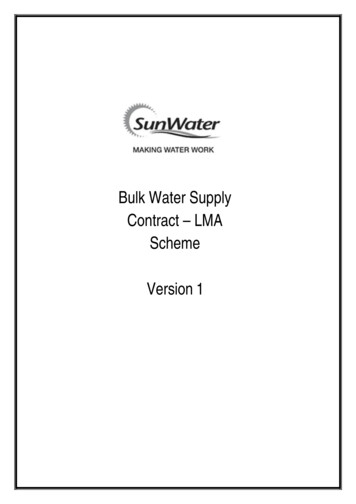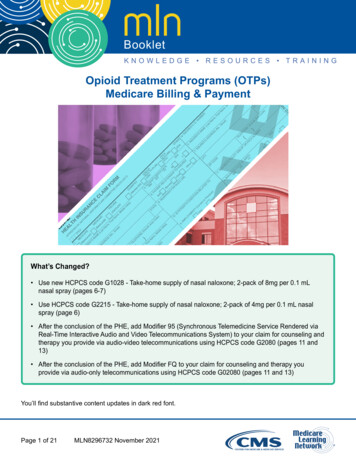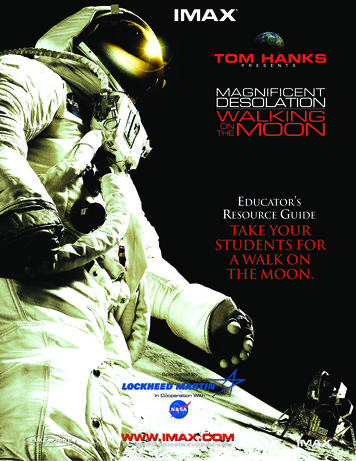
Transcription
EDUCATOR’SRESOURCE GUIDETAKE YOUrstudents fora walk onthe moon.
Table of ContentsLetter to Educators . . . . . . . . . . . . . . . . . . . . . . . . . . . . . . . . . . . . . . . .3Education and The IMAX Experience . . . . . . . . . . . . . . . . . . . . . . . .4Educator’s Guide to Student Activities . . . . . . . . . . . . . . . . . . . . . . . .5Additional Extension Activities . . . . . . . . . . . . . . . . . . . . . . . . . . . . . .9Student ActivitiesMoon Myths vs. Realities . . . . . . . . . . . . . . . . . . . . . . . . . . . . . . . . . .10Phases of the Moon . . . . . . . . . . . . . . . . . . . . . . . . . . . . . . . . . . . . . .11Craters and Canyons . . . . . . . . . . . . . . . . . . . . . . . . . . . . . . . . . . . . .12Moon Mass . . . . . . . . . . . . . . . . . . . . . . . . . . . . . . . . . . . . . . . . . . . . .13Working for NASA . . . . . . . . . . . . . . . . . . . . . . . . . . . . . . . . . . . . . . .14Living in Space Q&A . . . . . . . . . . . . . . . . . . . . . . . . . . . . . . . . . . . . . .16Moonology: The Geology of the Moon (Rocks) . . . . . . . . . . . . . . . .17Moonology: The Geology of the Moon (Soil) . . . . . . . . . . . . . . . . . .18Moon Map . . . . . . . . . . . . . . . . . . . . . . . . . . . . . . . . . . . . . . . . . . . . . .19The Future of Lunar Exploration . . . . . . . . . . . . . . . . . . . . . . . . . . . .20Apollo Missions Quick-Facts Reference Sheet . . . . . . . . . . . . . . . .21Moon and Apollo Mission Trivia . . . . . . . . . . . . . . . . . . . . . . . . . . . . .22Space Glossary and Resources . . . . . . . . . . . . . . . . . . . . . . . . . . . . .23
Dear Educator,Thank you for choosing to enrich your students’ learning experiences by supplementing your science, math, history and language arts curriculums with an IMAX film. Since inception, The IMAX Corporation hasshown its commitment to education by producing learning-based films and providing complementaryresources for teachers, such as this Educator’s Resource Guide.For many, the dream of flying to the Moon begins at a young age, and continues far intoadulthood. Although space travel is not possible for most people, IMAX provides viewerstheir own unique opportunity to journey to the Moon through the film, MagnificentDesolation: Walking on the Moon.USING THIS GUIDEThis Comprehensive Educator’s ResourceGuide includes an Educator’s Guide to StudentActivities (beginning on Page 5) to help youuse the contents fully. The Educator’s Guideto Student Activities is comprised of hands-onlessons and experiments to complete in theclassroom or outdoors, before or after filmviewing. The guide also includes:This thrilling IMAX film puts the audience right alongside the astronauts of theApollo space missions and transports them to the Moon to experience the firststeps on the lunar surface and the continued adventure throughout the Moonmissions. Audiences will be able to leap and bound beside the astronauts andjoin the race against the clock to pack as much science and sample collectionas possible into the limited stay time on the Moon’s surface. Movie-goers willshare in the courage, the excitement and the joy that accompanied thesemissions and cemented the Apollo program as a crowning achievement inNASA history.Turn your local IMAX theatre into an extension of your classroom asyour students discover the Moon and learn more about NASA’s lunarexploration endeavors. This Educator’s Resource Guide, created byWeekly Reader and IMAX, extends the Magnificent Desolation: Walkingon the Moon film experience into classroom activities that will continueto pique your students’ interests and help them learn long after the filmhas ended. 10 reproducible, corresponding student activities(beginning on Page 10) learning objectives and summaries for eachstudent activity ideas for implementing the student activities subject areas and recommended grade rangesfor each lesson page numbers of corresponding student activities follow-up activities for each lesson recommended Web sites for expandingthe topics covered in lessons answers, diagrams, and proceduresfor student activities additional extension activities a quick-fact reference sheet forstudents (Page 21) Moon and Apollo missiontrivia (Page 22)This 24-page Educator’s Resource Guide is designed for students ingrades 3 through 9, with activities that are appropriate for the varyinglearning levels in this grade span. The Educator’s Resource Guide offersreproducible student activities for each grade level that meet national standards. All of the activities can be adapted to meet the needs of your students.Hands-on lessons, experiments and observation activities will educate students about lunar exploration and the Moon. The Educator’s Resource Guidealso includes ideas for implementing the lessons, extension activities, resources,Web sites and a quick-fact reference sheet. Photocopy and share the referencesheets with students in order to build background for the film.Enjoy taking your students on a journey to the Moon and thank you for using IMAXfilms to challenge your students’ knowledge of space exploration. Although these materials are copyrighted, they may be reproduced for educational purposes. Please feel free toshare this guide with your colleagues and encourage them to book their field trip to seeMagnificent Desolation: Walking on the Moon.We look forward to seeing you and your students again at your local IMAX theatre.Sincerely,Your Friends at IMAX3
the imax experience about the filmThe twelve Apollo astronauts whowalked the lunar surface between theyears 1969 and 1972 lived for a brieftime in spaces only imagined. The Apolloproject was a stunning demonstration oftechnological virtuosity, and manyconsider that was all it needed to be. Theastronauts who made the million-milejourney to the Moon didn’t just bringback rocks and pictures; they broughthome the Moon as an extension ofhuman territory. No longer just a brightcircle in the night sky, people recognizedthe Moon as a place with mountains,valleys, canyons, and vast plains. TheApollo astronauts were true explorers,and only through the magic of The IMAXExperience can audiences go back to theMoon with them to see and hear theirstories in a way never before possible.4Education and The IMAX Experience IMAX films are designed to educate and enlighten as much as they are to entertain.They offer educators a powerful teaching tool that extends learning beyond theclassroom and integrates easily into existing curriculums. IMAX films provide studentswith unique and exciting opportunities to explore new worlds and new ideas.With breathtaking, crystal-clear images up to eight stories high and state-of-the-artsurround sound, The IMAX Experience takes viewers to places only imagined. Thehighly-specialized and precise projectors employ a unique system that ensuresoutstanding clarity and brightness. The IMAX Experience is completed by a speciallydesigned sound system, ensuring that each viewer receives the same sound quality.Only IMAX technology lets you feel as if you’re really there.More than 700 million people around the world have been mesmerized and educatedby The IMAX Experience. Technically advanced and visually stunning, The IMAXExperience continues to be the world’s most immersive theatre entertainment.IMAX invites your students to think big .
Educator’s guide to student activitiesMoon Myths vs. realities(Page 10)Phases of the Moon(Page 11)(Language Arts and Critical Thinking – All Grades)(Science – Grades 3-6)Objective: To strengthen students’ critical thinking andcomprehension skillsObjective: To strengthen observation skills and teach studentsabout the phases of the Moon.Have students write the myth and reality statements into the chartindependently before reading. Have groups read the upside downpassage so they can check their work. Then provide the additionalmyth and reality statements below and have students predict wherethey belong in the chart. Read aloud the explanations provided sostudents can check their predictions.For thousands of years, people have been watching and trackingthe phases of the Moon. The Moon’s 291 2-day calendar was thebasis for one of the earliest calendars on Earth. As students chartthe Moon’s phases, ask what geographic features are visible andwhy only one side of the Moon is visible to people on Earth at alltimes.The Moon “rises” and “sets”—just like the Sun. (Myth) Themoon doesn’t rise and set—and neither does the Sun. It seems likethe Moon rises and sets, but that’s just a trick of the eye. That’sbecause the Earth is spinning around and around at the same timethe Moon is going around it.If the Moon is not visible to students in your area (due to weatheror an increased amount of light), direct students to visitThe entire Moon has very cold temperatures. (Myth) Brr! On the“dark side” of the Moon, the average temperature is a chilly -279 F(-173 C). But it isn’t cold everywhere on the Moon. On the sunlitside, the average temperature is around 212 F (100 C). (The averagetemperature on Earth is 60 F, or 15.5 C.)The Moon doesn’t have weather. (Reality) The Moon doesn’t haveweather because it doesn’t have an atmosphere. That means there’sno rain, wind, or snow to disturb the surface of the Moon. (Evenfootsteps left by astronauts!)www.nasa.gov/audience/forkids/home/CS What Will Moon Look Like.htmlto view NASA’s daily online photos of the Moon.Extension ActivityAfter students have charted the Moon’s phases, ask them to predictthe future dates for the next month’s full Moon, new Moon, waxinggibbous and waning crescent. As an extra challenge, have theclass predict the dates of the Moon’s phases for an entire year andthen track the Moon’s calendar using your local newspaper orthe Internet.A lunar eclipse happens within a few minutes. (Myth) A lunareclipse occurs when the Earth is directly between the Sun and theMoon. The Earth will block the Sun’s light from reaching the moon.A lunar eclipse can occur for about 1 to 4 hours.Extension ActivityThe Moon has played a major role in stories, myths, plays, musicand art. It has inspired many tales in almost every culture, including Roman and Greek mythology and Native American and Africanlegends. Have students write their own myths or legends about theMoon. Since most traditional literature was shared through oralretellings, encourage students to read the stories aloud or ask agroup to act out a scene as a play.EXPAND THE IDEA!Check out this Web site to learn more about Moon e/myths.php5
Craters and Canyons(Page 12)(Math and Science – Grades 6 and up)Objective: To have students test and measure the sizes of modelasteroids and the “craters” they leave on the lunar surfaceThe Moon does not have an atmosphere to slow down objects coming towards it. For that reason, asteroids are able to hit the Moon’ssurface at high impacts, leaving many scars, or craters, on the lunarsurface. In this activity, students will measure and chart the size ofthe craters left by asteroids on a model lunar surface.Extension ActivityAs students are performing the “Craters and Canyons” activity, askthem to observe the ejecta—the debris or dust that is thrown offduring an impact and formation of a crater. Try measuring the distance of the model ejecta (the dirt or flour that flies outwards uponimpact). You can also ask students to repeat the experiment from adistance above the pan or bowl. As an extra challenge, ask studentsto predict the differences in the width and depth of the craters fromthe higher distances and then confirm their predictions after performing the activity. Students can also convert all weights andmeasurements to the metric system.Moon Mass(Page 13)(Math – Grades 6 and up)Objective: To develop students’ computation skills as theycompare gravity on the Earth and the MoonThis activity will complement your existing science curriculum ongravity, forces, and types of energy. The force of gravity on theMoon is about 1 6 as strong as it is on the Earth. To help studentsunderstand this fractional comparison, use a simpler example,such as 1 2, to explain why the weight of objects on Earth are divided by 6. (If the pull of gravity on another celestial body is 1 2 the pullof gravity on Earth, you would divide by 2—the denominator.)Older students can try using 0.165 in place of 6. (To explain why itcan be used, tell students that there is a mathematical formula forcomparing the forces of gravity on the Earth and Moon. The formula involves finding the ratio between the force of gravity on theMoon and the force of gravity on the Earth. The force of gravity iscalculated using the masses and radiuses of each. It is determinedthe same way for planets and other celestial bodes.)1Extension ActivityThe “giant leap” Neil Armstrong took while on the Moon demonstrates the effect a weaker gravitational pull would have on objects.Explain that gravity holds an object down on Earth. On the Moon,objects seem to float or remain suspended longer than on Earth. To6demonstrate this concept, ask students to take a “giant step.”Compare the amount of time that lapses during a step each studenttakes to that of the “giant leap” made by Neil Armstrong whileon the Moon.Extension ActivityAsk students to name people that experience microgravity, otherthan astronauts. Sky divers and trampoline acrobats experienceweightlessness for up to a few seconds when they “free fall.” Sodo people that ride roller coasters. Trained pilots can also experiencethe effects of low gravity when they fly a parabolic, or bellshaped, maneuver at altitudes between 24,000 and 32,000 feet.The plane is pulled up “nose high” at a 45 degree angle. When theplane makes it over the top of the maneuver, the pilots experienceweightlessness for about 25-30 seconds. Draw a parabola on thechalkboard or chart paper and point out the top area whereweightlessness will occur.working for nasa(Pages 14-15)(Language Arts and Math – All Grades)Objective: To have students answer an interest inventory todiscover NASA careers that might be right for themNASA employs over 400,000 people in a variety of positions,including researchers, scientists, engineers, computer programmers, technicians, personnel specialists and media executives. Butthe most popular and well-known of all of NASA’s employees arethe astronauts.Many people dream about becoming an astronaut. This activityallows students to see if they have what it takes to journey intospace, or work as another important member of the NASAteam. Here are some specific requirements for becoming aNASA astronaut.NASA requirements for mission specialist astronauts: A four-year Bachelor’s degree in engineering, biological science,physical science or mathematics; a Masters or Doctorate (Ph.D.)is desirable At least three years of professional experience related to yourcollege degree Ability to pass a NASA space physical, including:Eyesight: 20/20 or better uncorrected, 20/20 corrected (withglasses or contacts)Blood pressure: no higher than 140/90 (measured in a sittingposition)Height: between 58.5 and 76 inches
To be a pilot astronaut, you also need: At least 1,000 hours of pilot-in-command flying time in ajet aircraft Height between 64 and 76 inchesExtension ActivityMake a class list of occupations at NASA, from the astronauts andengineers to the maintenance crew and security staff. Point outthat students who are not inclined to fields in math or science canstill work at a space agency in various positions.EXPAND THE IDEA!Check out this Web site to learn more about NASA careers:http://edspace.nasa.gov/careersliving in space Q&A(Page 16)(Language Arts and Math – All Grades)Objective: To have students examine how everyday tasksare done in space and compare them to analogous situationsLiving in orbit or on a space station is a lot like living on Earth—astronauts eat, sleep, work, exercise, and play. Astronauts eatthree planned meals a day, plus snacks. They also spend a lot oftime just preparing the meals.Mix-up a space meal to eat here on Earth just like an astronautwould do! Here’s how:Ingredients:1 box of instant pudding (2.5oz.)1 4 cup of dry milk2 cups of water (warm or cold)a sandwich-sized zipper bagMethod:1. Empty the box of instant pudding into the zipper bag.2. Add the dry milk.3. Zipper and shake the sandwich bag to blend the contents.4. Open the bag and add the two cups of water.5. Zipper the bag again. (Be sure that it isn’t filled with air.)6. Knead the bag gently until all the ingredients havecombined.7. Eat the pudding using a spoon or punch a small hole intoone corner and squeeze it into your mouth!EXPAND THE IDEA!Log on to http://spaceflight.nasa.gov/living to learn more aboutthis topic. Have students visit www.ag.iastate.edu/centers/ftcsc/pages/meal.htm# to see a photo of a real space food tray.Extension ActivityHave students check refrigerators and cupboards at home andthen list five things that astronauts could eat in space and fivethings they could not. (Hint: No crumbs allowed in space!)Extension ActivityAstronauts need a break from their busy daily schedules. Days oreven months of straight work is certain to cause stress amongcrew members. That’s why flight planners on Earth schedule timeduring each day for astronauts to relax, exercise and have fun.Astronauts talk to friends and family using special phones thatcall directly home! They also listen to musical wake up calls. Logon to x.htmlto have students hear a few.moonology: The Geology of(Pages 17-18)the Moon(Science and Math – Grades 3-5)Objective: To strengthen students’ scientific inquiry abilities bycollecting, observing, and analyzing dataIn this two-part activity, students will collect rock and soil samples as the astronauts did during the Apollo missions. Studentswill use the samples to learn more about the geology where theylive—just like scientists and geologists learned about the Moonfrom the Apollo samples.ROCKSThe Apollo Moon missions succeeded in bringing 843 pounds ofrocks and soil samples from the Moon for scientists and geologists to study here on Earth. From these samples, it has beenlearned that: The Moon was once active with volcanoes and had a magma core. The lack of wind and water on the Moon means there is no erosion to wear away the lunar surface. This has allowed the Moon’ssurface to remain virtually unchanged for thousands of years. Because the Moon does not have an atmosphere, its dust-covered regolith (or surface) becomes embedded with particles fromsolar winds. Solar winds leave deposits on the Moon that mayhold clues to the formation of the universe. Footprints left behind by astronauts more than 30 years ago willremain on the Moon’s surface for thousands of years. The Moon scientists are studying today, through rocks and dustcollected during missions, is pretty close to the same Moon thatexisted thousands of years ago.7
Extension ActivityHave students sort all of the rocks collected according to thesecategories: size, color, shape, hardness. Encourage students topoint out similarities and differences among the rocks. Pick upthe National Audubon Society Field Guide to North AmericanRocks and Minerals (Audubon Society Field Guide) by CharlesWesley Chesterman to help you identify the rocks. Then weigh allthe rocks students collected and compare the total weight to thatof the 843 pounds of Moon rocks collected by Apollo astronauts.SOILYou’ll need: two (2) plastic zipper bags gardening shovel measuring cups and spoons distilled water pH strips magnifierWhat to do:1. Find a location site (backyard, street corner, under a tree orflowering plant).2. Label two plastic zipper bags with the location site.3. Use a gardening shovel to dig into the soil (about 6 inchesdeep).4. Scoop one tablespoon of soil and place it into a plastic zipper bag. Scoop a second tablespoon into the other bag.5. Add 1 4 cup of distilled water into the first bag.6. Zipper the bag closed, and then shake!7. Dip a pH strip into the soil-water mixture.8. Match the color change on the pH strip with the key on thecontainer. (7 Neutral; Less than 7 acidic; Greater than7 basic)9. Empty the soil from the second bag onto a white piece of paper.10. Observe the soil using a magnifier. (Notice the color andshape of the grains.)Extension ActivityThe tines on the rakes used by astronauts were only one centimeter apart. Draw lines one centimeter apart at the bottom of a pieceof construction paper. Cut along each of the lines and then cut outevery other flap. Have students look closely at the small spacebetween each. Ask: What objects on Earth do you think you couldgather using a rake like this?8EXPAND THE IDEA!Check out this Web site to learn more about this plex?keywords cratersMoon map(Page 19)(Math – Grades 5 and up)Objective: To have students use charts to learn more about thelunar landing sites.In 1961, President John F. Kennedy challenged the nation to senda man to the Moon before the end of the decade.I believe that this nation should commit itself to achieving thegoal, before the decade is out, of landing a man on theMoon and returning him safely to Earth.— President Kennedy’s State of the Union Speech, May 25, 1961That goal was achieved with the Apollo 11 mission on July 20,1969, when Neil Armstrong took the first step on the lunar surface.Six more Apollo missions to explore and study the Moon followed.In 1972, Apollo 17 was the last crew to visit the Moon.This activity provides a brief introduction to the Apollo missionsand the areas of the Moon that were explored during the yearsNASA astronauts walked on the lunar surface. Students will readabout the landing sites and then plot their positions using a grid.Once the activity is completed, discuss the various landing siteswith your students. Ask the class why those sites might havebeen chosen.IMAX Extra! Answer: 93 kilometers is almost 58 milesThe Future of LunarExploration(Page 20)(Language Arts – Grades 7 and up)Objective: To strengthen students’ debate and persuasive writingskills as they argue their position on the future of lunar explorationShould the Moon be colonized? NASA plans to return lunar roversand astronauts to the Moon by the year 2020. There is also a mission to Mars underway, as scientists prepare for landing an astronaut safely on the Red Planet. Students will use this activity to puttheir persuasive writing skills to the test to acquire funding forfuture space missions, and debate whether or not the Moon shouldbe colonized, or developed for civilization.Extension ActivityTake a class poll to learn the number of students willing to liveon the Moon. Ask students to poll adults and then comparethe results.
ADDITIONAL EXTENSION ACTIVITIESThe Moon’s OrbitSpacesuitsTo help students understand the rotation and orbit of the Moon, trythe demonstration below. (You can modify the activity to demonstratehow the nine planets orbit around the Sun.) You will need a flashlight,aluminum foil, ruler, a ball about the size of a baseball, and a ballabout the size of a golf ball.The spacesuits worn by the astronauts on the Apollo 11 missionwere self-contained life support systems that weighed 180-pounds.The NASA spacesuit has not changed drastically over the past threedecades—it still has a large “bubble” helmet that attaches to thesuit. Astronauts still wear caps with radios and microphones and abodysuit with special tubing to keep cool in extreme heat. Cover the smaller ball with aluminum foil. This will represent theMoon. The larger ball will represent the Earth. Place the Earth and Moon models on a table, about 8 inches apart. Turn the flashlight on and lay it three feet from Earth and Moonmodels (you may need to place the flashlight on top of a fewmath and science books for the best exposure). The flashlight willrepresent the Sun. Use your finger to slowly move the Moon around the Earth.Be sure to keep the Moon at the same 8-inch distance from theEarth as you move it through its orbit.Have students notice the way the flashlight reflects light onthe model Moon. This is the way the Moon appears to beilluminated from the perspective of the Earth. Compare thisdemonstration to the Moon’s phases for a complete lunarcalendar (291 2 days).Have students research the NASA spacesuits and those of otherspace agencies. Then get students to design their own version ofspacesuits that meet all of the astronauts’ needs, including extremetemperatures, movement, safety, communication and durability.As a follow-up, compare the NASA spacesuit to a firefighter’ssafety equipment and early diving gear. Similarities: self-contained breathing apparatus, protection from the elements andthey permit people to move and do their jobs.Space InventionsDuring NASA’s four decades of space travel and exploration, manyinventions and tools that have been designed for astronauts havemade their way into the mainstream in order to make people’s everyday lives easier. For instance, the cordless drill was first developed forastronauts who didn’t have an outlet on board their spacecraft. Havestudents research other NASA inventions that have improved life forthose of us on Earth.Expand the Experience!Space Camp and Aviation Challenge, located in Huntsville, AL, use space and aviation as a platform to excite and educatechildren ages 9-18 in the fields of math, science and technology. Programs run from 3-13 days, during which teamwork,self-confidence and communication are achieved through state-of-the-art simulations, missions and training.Visit www.spacecamp.com or call (800) 63-SPACE for more information.Challenger Learning Centers offer realistic mock-ups of Mission Control and an orbiting space station. Students “rev up”their imaginations and work together toward the mission’s goal, whether it is the launching of a probe or the interception ofa comet. E-mail ns@challenger.org or log on to www.challenger.org for more information on student programs.9
10 2005 IMAX Corporation and Playtone.Created by Lifetime Learning Systems , Inc., a division of Weekly Reader Corporation.Put down the crackers because the Moon isn’t made of cheese! It’s made of dust and many types of rocks, especially those that formed after volcanoes erupted on the Moon. It’salso a fact that there isn’t any water on the Moon.If you dream of becoming an astronaut but don’t like long rides, don’t worry, a trip to the Moon is not that far—between 227,000 and 254,000 miles away. (A road trip from NewYork to California is only about 3,000 miles!) The Moon is our closest neighbor. It’s also about 2,161 miles wide—almost as wide as Australia at it widest points.The Moon doesn’t really have a “dark side” but one side of the Moon is never seen from Earth. That’s because the Moon takes about 27 days to orbit the Earth, and about the sameamount of time to spin once on its axis. The side of the Moon we do not see gets just as much sunlight on it as the side we do see.The Moon does exert gravity on people and things, just not as much as the Earth does. On the Moon, people and things weigh about one-sixth of their weight on Earth. (One-sixthis much less than one-half.) That’s why astronauts seem to “float” on the surface of the Moon.Astronomers have seen a “tail” that streams from the Moon, although it can’t be seen without a telescope. It is actually a 15,000-mile, glowing trail of sodium gases that is orangein color. Speaking of color, when two full moons occur in a single month, the second full moon is called a “Blue Moon.” The Moon doesn’t turn blue during the Blue Moon phase.However, “once in a blue Moon” (every two or three years) the Moon will have a bluish color during this phase.MythReality The Moon is made of cheese. The Moon has a dark side. There is no water on the Moon. It takes the Moon 29 days to complete its orbit. The Moon is located millions of miles from the Earth. People don’t feel a gravitational pull when on the Moon. The Moon is the Earth’s nearest neighbor in space. The Moon has a tail. Australia is wider than the Moon. The Moon turns blue during the Blue Moon phase.See if you can tell the difference between a Moon myth and reality. Read each statement below and decide if it is true or false. Write thestatements in the chart under the headings you decide. Then turn the page upside down and read the short passage to check your work.Here’s your mission:Is the Moon made of cheese? Is there really a man in the Moon? No! These are just Moon myths, or imaginary stories and beliefsabout the Moon. Reality is something that is an actual fact, such as: The Moon orbits the Earth and The Moon is the Earth’s nearestneighbor in space. Some facts about the Moon sound like myths but they’re really true. Other ideas about the Moon are not at all true,but it is difficult to convince people to think differently. In this activity you will decide if a Moon statement is true (reality) or false (myth).Moon myths vs. realitiesName
NamePhases of the MoonThe Moon takes about 291 2 days to complete its phases. The Moon doesn’t actually change shape during each phase, we just see differentamounts of sunlight reflected off of the Moon’s surface. The phases are the changes in the different amounts of lighted surface of theMoon that we can see from Earth. During the New Moon phase, the Moon is between the Earth and the Sun. The side of the Moon thatis not lit is facing the Earth, so we don’t see the Moon during that phase.Here’s your mission:Observe the Moon every night for 30 days. Draw what you see each night in the correct box. After a month, you will have witnessed acomplete Moon 7282930The New Moon could be seen on this date:The Waxing Gibbous occurred on these dates:The Full Moon occurred on these dates:The Waning Crescent oc
to view NASA's daily online photos of the Moon. Extension Activity After students have charted the Moon's phases, ask them to predict the future dates for the next month's full Moon, new Moon, waxing gibbous and waning crescent. As an extra challenge, have the class predict the dates of the Moon's phases for an entire year and
